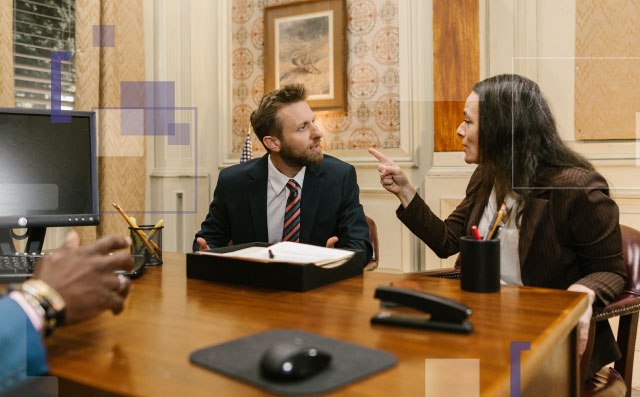
Have you ever tried to solve a complicated problem and thought, “If only there were a rulebook to help me figure this out?”
Fortunately, eDiscovery has one with the Federal Rules of Civil Procedure (FRCP). Just as its name implies, the FRCP is a set of rules governing how civil law functions, including timelines and expectations. There are also versions of this for state laws, but many of these follow the lead of the FRCP.
When you couple the FRCP with case law, it’s pretty easy to get an idea of how things work, what judges expect, and how to craft your legal team’s procedures and protocols accordingly.
And yet, there are still countless examples of organizations making the same old mistakes which could have been avoided if they’d only used the guidance laid down in the FRCP.
One of these is the “Meet and Confer” conference established by Rule 26(f).
It states: “In conferring, the parties must consider the nature and basis of their claims and defenses and the possibilities for promptly settling or resolving the case; make or arrange for the disclosures required by Rule 26(a)(1); discuss any issues about preserving discoverable information; and develop a proposed discovery plan.”
It also establishes the timeline for this conference as being, “21 days before a scheduling conference is to be held or a scheduling order is due under Rule 16(b),” or in other words: 69 Days from the initial complaint!
That’s not a lot of time to get things together.
Parties must work together
Before the so called “eDiscovery Amendments” to the FRCP in 2015, that timeframe was 30 days longer, and there wasn’t much expectation on coming to the meet and confer prepared. Often, parties with more time and resources would make broad requests, hoping to bury the case in discovery, which is what this week’s eDiscovery Blues cartoon is having a little fun with.
But these days, cooperation is the name of the game, and judges expect both parties to come to the meet and confer prepared and ready to work together. How do I know? Because it’s written right into Rule 26 (if you missed it, see 3 paragraphs above). And to support that, as I said, all you have to do is look at case law.
In fact, just this week, Doug Austin, editor of eDiscovery Today, wrote about Healthedge Software, Inc. v. Sharp Health Plan, No. 19-cv-11020-ADB (D. Mass. May 6, 2021) where the judge had to order both parties to cooperate. Massachusetts District Judge Allison D. Burroughs stated in her ruling that the “defendant is to provide…a proposed collection and search protocol, including a list of custodians and search terms. In crafting this proposed protocol, the Court encourages Sharp to keep in mind that requiring HealthEdge to review hundreds of thousands of documents in this litigation is likely to be unduly burdensome and/or disproportional to the needs of the case…Then, depending on how many hits are generated using Sharp’s proposed protocol, HealthEdge shall either review the hits (and produce responsive, non-privilege documents) or make a counterproposal.”
For the opposing party, Judge Burroughs ordered the defendant to “promptly disclose to HealthEdge (1) which custodians’ documents were collected and (2) precisely how it filtered those documents to arrive at its proposed review universe (i.e., date ranges, search terms, de-duping methods, etc.)….If HealthEdge believes Sharp’s collection and/or filtering methodology was deficient, the parties shall engage in good faith negotiations to agree upon a collection and review protocol (following the general blueprint described above).”
If only they’d come to their meet and confer prepared and ready to cooperate!
Information Governance can help
This is where Information Governance (IG) comes in. By understanding your organization’s data landscape before litigation takes place, you’re well on your way to being prepared when it does. The early insights that IG gives an organization provide a head start when it comes to identifying relevant custodians, search terms, privilege and privacy concerns, and potential challenges when it comes to collecting new data types like collaboration tools and social media.
The other benefit an active Information Governance program brings your legal team is the ability to defensably delete data by reducing ROT (redundant, obsolete, trivial), thereby keeping things tidy and easier to manage when it comes time to begin working with outside counsel.
It also reduces costs, because when that 69-day timeline starts ticking, and outside counsel is trying to prepare for the meet and confer, many organizations simply send over large amounts of data to their firm, which then translates in large eDiscovery costs. A company that already has data managed and organized, as well the ability to do preliminary searches, has the ability to only send relevant information to their law firm.
It’s a win / win.
So if you want to sail into your meet and confer prepared, you have to start long before litigation arises. If you don’t, you’ll look like the attorney in the cartoon above, trying to smooth talk his way out of trouble, which doesn’t work with judges. Instead, implement an information governance program and gain control and insights over your data, so you can walk into your 26(f) conference with confidence.
Learn more about how IPRO’s suite of information governance solutions can help your organization come prepared to a meet and confer.


